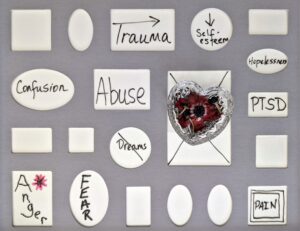By Dr. Michelle Garnett and Professor Tony Attwood
We write this article to assist parents and teachers to encourage friendship skills because we seek to give them skills for navigating a social world that can be confusing and rejecting if they do not know the codes. An analogy is that it is a bit like moving to Japan and choosing to learn the customs and language to be able to find friends and a job, not to become Japanese. Part 1 of this article included several strategies for encouraging friendship at primary school. We discuss four more strategies in this article and include the list of helpful resources. It is important to emphasise that, in addition to explicitly teaching autistic children about the social and emotional world, we also need to educate and support non-autistic children how to be more understanding, supportive and inclusive to their autistic friends.
Create a Buddy System
A buddy system can be very helpful to provide inclusion and safety for many autistic children but especially for a very isolated or withdrawn child. We recommend that a team of 2-3 kind and socially skilled peers are chosen by the teacher to assist the child where needed in the classroom and playground. Buddies can be encouraged to protect the child from possible bullies and to include them in their group, even if the autistic child choose to be a nonactive member at times. Careful and sensitive education about the child’s profile, including their social code, to well-chosen peers can assist to help explain their social differences in a non-judgemental way. The resource “The Sixth Sense-II” by Carol Gray (2003) is a program written for primary school teachers to assist in education of peers in this way.
Talk about friendship
Autistic children can struggle to recognise and understand friendship intuitively, even though they may long for a friend, it can be helpful to talk about friendship at home, including friendship as an everyday topic of conversation. What seems obvious to you may not be obvious to your autistic child or student. Notice when your child is being friendly and describe those times as being times when your child is making smart and mature choices. Ask about any times of social confusions where they did not understand why a friend did or did not do something. Often it is the intention that is confusing, but sometimes it is the facial expression or body language.
A social communication book can be arranged between parents and teacher, to communicate how friendship is going in the classroom and current coping with emotions and socialising. When parents understand the social problems that are emerging then they can assist by providing the social information needed to interpret the situation and to know what to do. When your child arrives home from school, they will need time to relax, ‘chill out’ and be by themself. However, at some time during the evening, ask how the day was using specific questions, e.g. ‘Was there a time today that you felt good?’ Or ‘Did you have a time today where you felt confused?’ ‘Yes’ and ‘No’ questions will help illicit more information to go through what happened and to discuss a strategy that might be useful for future situations. This type of approach can be utilised by a teacher at school as well as by his parents.
Autistic children need to be taught social understanding explicitly. We recommend using Comic Strip Conversations and Social Stories from Carol Gray for this purpose (see the link to these ideas in the Resources section below). It is important to make these discussions short and to validate your child’s view first as needed, before providing new information. The process is about collaboration and discovery with the goal to minimise confusion and increase understanding people, rather than about pointing out and correcting perceived errors. Be a kind and compassionate collaborator. If your child is very sensitive and feels criticised, provide only a debrief and then validation for their hurt, confusion, or despair. If they are very active in their refusal to discuss friendship, ask them what they would prefer to talk about and spend time on their chosen topic instead. Use other strategies as listed to encourage friendship. In these cases we find it is important to check in at school to determine how the child is managing with friendship and the use of a Buddy System, Success Book and a Social Communication book with the teacher may be helpful.
Provide moments of incidental learning
We recommend that a teacher’s aide help facilitate friendships at school. We encourage teacher’s aides to observe the child, and the other children in the class to determine the social code of the classroom, and which social goals would be helpful for each child, since it takes two to create a successful interaction. Once or twice a week, ask the teacher’s aide to observe the children in play, and then later, in private, sensitively give each child that needs help information about what they are doing well, and to brainstorm together solutions to any social problems that are occurring. Incidental learning and mentoring are very valuable in teaching all children social skills, including e.g. acts of kindness, empathy, and inclusion.
Help your child to find friends with whom they can be themselves
In high school and beyond people tend to choose friends with similar interests, thinking styles and values. Successful friendships in primary school are usually based on shared interests. Consider what you child loves to do most and create opportunities for them to meet others with similar interests. The interests may be on screen, and not the interests you would necessarily choose for you child. Our recommendation is to go with your child’s interests if the interests are safe and age appropriate. It can be difficult to let go of the child we dreamed of having and accept the child as they are. When we can do this, we create the space our child to also accept themselves as they are.
It is very helpful for schools to create safe structured places for all kids, for e.g. a Chess, Minecraft, Science, Lego, Writing or Drama Club at lunch time, depending on the interests of the children at the time who would benefit from these friendship clubs. We have also seen the creation of a Friendship Club, or a Friendship Bench, work very well at primary school, a place set up especially for children who are feeling alone but would like to meet new friends.
In summary
Raising an autistic child to both develop friendship skills and to accept themselves can be a difficult path to navigate. Over two articles we have given eight recommendations based on research and our own clinical experience, incorporating our understanding that autistic friendship can be different from non-autistic friendship, but also that the child needs the skills to navigate the dominant social paradigm to be able to live a full life. The path can be exhausting and frustrating for parents and teachers. As much as is possible we also recommend being kind and compassionate to oneself whilst assisting your child or student.
Where to from here?
We have created two half-day courses on Autism and Friendship in Primary School within which we discuss the various issues that can arise for autistic children as they seek to build friendships and how to support them to do whilst being authentic to themselves.
Exploring Friendship in the Primary Years
Exploring Friendship in High School
Resources
Social Stories and Comic Strip Conversations:
Social Curricula for Primary School Children:
Recommended books:
The Sixth Sense II: Sharing Information About Autism Spectrum Disorders with General Education Students, By: Carol Gray (2003), Published by Future Horizons Inc, USA.
Teaching Social Skills to Children with Autism using Minecraft London, by Dundon & Scott, Jessica Kingsley Publishers, Web: www.jkp.com
How Lego-based Therapy for Autism Works by LeGoff et al Jessica Kingsley Publishers, Web: www.jkp.com
Making Friends: A Guide to Getting Along with People by Andrew Matthews, published by Media Masters
Socially Curious and Curiously Social by Michelle Garcia Winner and Pamela Crooke, published by Jessica Kingsley Publishers, Web: www.jkp.com
Building Healthy Friendships: Teaching Friendship Skills to Young People by Terry A. Beck, published by R & E Publishing
What is Friendship?: Games and Activities to Help Children to Understand Friendship by Pamela Day, published by Jessica Kingsley Publishers, Web: www.jkp.com
The Friendship Formula: A Social Skills Programme to Develop an Awareness of Self and Others by Alison Schroeder, published by LDA Learning, Web: www.ldalearning.com.
Exploring Friendships, Puberty and Relationships: A Programme to Help Children and Young People on the Autism Spectrum to Cope with the Challenges of Adolescence by Kate Ripley, published by Jessica Kingsley Publishers, Web: www.jkp.com
Making & Keeping Friends: Ready-to-Use Lessons, Stories, and Activities for Building Relationships by John J. Schmidt, published by Jossey-Bass Publishers
A Good Friend: How to make one, how to be one by Ron Herron and Val J. Peter, published by Boys Town Press, Web: www.boystownpress.org
The Science of Making Friends: Helping Socially Challenged Teens and Young Adults by Elizabeth Laugeson, published by John Wiley & Sons Inc., Web: www.wiley.com
ACT It Out: Social Skills for Teens with Autism Spectrum Disorder and Related Disorders by Jeannie Stefonek, published by AAPC Publishing, Web: www.aapcpublishing.com
Acting Antics: A Theatrical Approach to Teaching Social Understanding to Kids and Teens with Asperger Syndrome by Cindy B. Schneider, published by Jessica Kingsley Publishers, Web: www.jkp.com.
Friendly Facts: A Fun, Interactive Resource to Help Children Explore the Complexities of Friends and Friendship by Margaret-Anne Carter and Josie Santomauro, published by AAPC Publishing, Web: www.aapcpublishing.com
Thinking About YOU, Thinking About ME: Teaching perspective taking and Social Thinking® to persons with Social Cognitive Learning Challenges by Michelle Garcia Winner, published by Think Social Publishing, Web: www.socialthinking.com.
Friendly Kids, Friendly Classrooms: Teaching Social Skills and Confidence in the Classroom by Helen McGrath and Shona Francey, published by Pearson Education Australia, Web: www.pearson.com.au
References
Bayer J. K., Mundy L., Stokes I., Hearps S., Allen N., Patton G. (2018). Bullying, mental health and friendship in Australian primary school children. Child and Adolescent Mental Health, 23(4), 334–340. https://doi.org/10.1111/camh.12261
Brendgen M., Vitaro F., Bukowski W. M., Dionne G., Tremblay R. E., Boivin M. (2013). Can friends protect genetically vulnerable children from depression? Development and Psychopathology, 25(2), 277–289. https://doi.org/10.1111/j.1467-8624.2007.01108.x
Bukowski W. M., Laursen B., Hoza B. (2010). The snowball effect: Friendship moderates escalations in depressed affect among avoidant and excluded children. Development and Psychopathology, 22(4), 749–757. https://doi.org/10.1017/S095457941000043X
Milton D. E. (2012). ‘Natures answer to over-conformity’: Deconstructing pathological demand avoidance. Autism Experts. https://kar.kent.ac.uk/62694/
Mitchell, P., Sheppard, E. and Cassidy, S. (2021), Autism and the double empathy problem: Implications for development and mental health. Br J Dev Psychol, 39: 1-18. https://doi.org/10.1111/bjdp.12350
O’Connor, R.A., van den Bedem, N., Blijd-Hoogewys E., Stockmann, L. & Rieffe, C. (2022). Friendship quality among autistic and non-autistic (pre-) adolescents: Protective or risk factor for mental health? Autism, 26:8, 2041-2051




